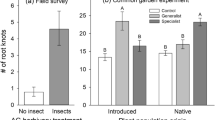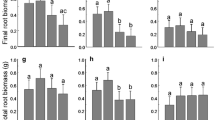Summary
Centaurea maculosa seedlings were grown in pots to study the effects of root herbivory by Agapeta zoegana L. (Lep.: Cochylidae) and Cyphocleonus achates Fahr. (Col.: Curculionidae), grass competition and nitrogen shortage (each present or absent), using a full factorial design. The aims of the study were to analyse the impact of root herbivory on plant growth, resource allocation and physiological processes, and to test if these plant responses to herbivory were influenced by plant competition and nitrogen availability. The two root herbivores differed markedly in their impact on plant growth. While feeding by the moth A. zoegana in the root cortex had no effect on shoot and root mass, feeding by the weevil C. achates in the central vascular tissue greatly reduced shoot mass, but not root mass, leading to a reduced shoot/root ratio. The absence of significant effects of the two herbivores on root biomass, despite considerable consumption, indicates that compensatory root growth occurred. Competition with grass affected plant growth more than herbivory and nutrient status, resulting in reduced shoot and root growth, and number of leaves. Nitrogen shortage did not affect plant growth directly but greatly influenced the compensatory capacity of Centaurea maculosa to root herbivory. Under high nitrogen conditions, shoot biomass of plants infested by the weevil was reduced by 30% compared with uninfested plants. However, under poor nitrogen conditions a 63% reduction was observed compared with corresponding controls. Root herbivory was the most important stress factor affecting plant physiology. Besides a relative increase in biomass allocation to the roots, infested plants also showed a significant increase in nitrogen concentration in the roots and a concomitant reduction in leaf nitrogen concentration, reflecting a redirection of the nitrogen to the stronger sink. The level of fructans was greatly reduced in the roots after herbivore feeding. This is thought to be a consequence of their mobilisation to support compensatory root growth. A preliminary model linking the effects of these root herbivores to the physiological processes of C. maculosa is presented.
Similar content being viewed by others
References
Andersen DC (1987) Below-ground herbivory in natural communities: a review emphasizing fossorial animals. Q Rev Biol 62:261–286
Baldwin IT (1990) Herbivory simulations in ecological research. Trends Ecol Evol 5:91–93
Belsky AJ (1986) Does herbivory benefit plants? A review of the evidence. Am Nat 127:870–892
Bergmeyer HU (1974) Methoden der enzymatischen Analyse. 3. Auflage, Verlag Chemie, Weinheim
Bernstein L, Hayward HE (1958) Physiology of salt tolerance. Annu Rev Plant Physiol 9:25–46
Bokhari UG (1977) Regrowth of western wheat grass utilizing 14C-labelled assimilates stored in below ground parts. Plant Soil 48:115–127
Brown VK, Gange AC (1989a) Herbivory by soil-dwelling insects depresses plant species richness. Funct Ecol 3:667–671
Brown VK, Gange AC (1989b) Differential effects of above- and below-ground herbivory during early plant succession. Oikos 54:67–76
Brown VK, Gange AC (1990) Insect herbivory below ground. Adv Ecol Res 20:2–58
Chapin FS III, Bloom AJ, Field CB, Waring RH (1987) Plant responses to multiple environmental factors. BioScience 37:49–57
Cottam DA, Whittaker JB, Malloch AJC (1986) The effects of chrysomelid beetle grazing and plant competition on the growth of Rumex obtusifolius. Oecologia 70:452–456
Crawley MJ (1983) Herbivory, the dynamics of animal- plant interactions. Blackwell Publications, Oxford
Crawley MJ (1989) Insect herbivores and plant population dynamics. Annu Rev Entomol 34:531–564
Cuda JP, Sindelar BW, Cardellina II JH (1989) Proposal for an integrated management system for spotted knapweed (Centaurea maculosa Lam.). In: Fay PK, Lacey JR (eds) Proceedings of the 1989 knapweed symposium. Bozeman, Montana, pp 197–202
Dintenfass LP, Brown GC (1988) Quantifying effects of clover root curculio (Coleoptera: Curculionidae) larval feeding on biomass and root reserves of alfalfa. J Econ Entomol 81:641–648
Dostal J (1976) Centaurea L. In: Flora Europaea. Vol 4, Cambridge Univ Press, pp 254–301
Dropkin VH (1989) Introduction to plant nematology. John Wiley, New York
Ellenberg H (1977) Stickstoff als Standortfaktor, insbesondere für mitteleuropäische Pflanzengesellschaften. Oecol Plant 12:1–22
Eltoum EMA, Berry RE (1985) Influence of garden symphylan (Symphyla: Scutigerellidae) root injury on physiological processes in snap beans. Environ Entomol 14:408–412
Gange AC, Brown VK (1989) Effects of root herbivory by an insect on a foliar feeding species, mediated through changes in the host plant. Oecologia 81:38–42
Gassmann A, Shorthouse JD (1990) Structural damage and gall induction by Pegomya curticornis and Pegomya euphorbiae (Diptera: Anthomyiidae) within the stems of leafy spurge (Euphorbia x Pseudovirgata) (Euphorbiaceae). Can Entomol 122:429–439
Godfrey LD, Yeargan KV, Muntifering RB (1987) Digestibility, protein content and nutrient yields of alfalfa stressed by selected early season insect pests and diseases. J Econ Entomol 80:257–262
Goldson SL, Jamieson PD, Bourdot GW (1988) The response of field-grown lucerne to a manipulated range of insect-induced nitrogen stress. Ann Appl Biol 113:189–196
Grace JB, Tilman D (eds) (1990) Perspectives on Plant Competition. Academic Press, New York
Harris P (1981) Stress as a strategy in the biological control of weeds. In: Papavizas GC (ed) Biological control in crop protection. BARC Symposium 5. Allenheld, Osmun, Totowa, pp 333–340
Harris P, Myers JH (1984) Centaurea diffusa L. and C. maculosa Lam., diffuse and spotted knapweed (Compositae). Pest status. In: Kelleher JS, Hulme MA (eds) Biological control programmes against weeds in Canada, 1969–1980. Commonwealth Agricultural Bureau, London, pp 127–137
Hartley SE (1990) What are galls for? Testing the nutrition hypothesis. In: Szentesi A (ed) Proceedings of the 7th International Symposium on Insect-Plant Relationships. Hungarian Academy of Sciences, Budapest pp 265–274
Hendrix SD (1988) Herbivory and its impact on plant reproduction. In: Lovett Doust J, Lovett Doust L (eds) Plant Reproductive Ecology: Patterns and Strategies. Oxford University Press, 246–263
Humphries EC (1958) Effect of removal of a part of the root system on the subsequent growth of the root and shoot. Ann Bot 22:251–257
Künsch U, Schärer H, Temperli (1977) Zur Automatisierung der Bodenanalyse. Schweizerische landwirtschaftliche Forschung 16:141–153
Ladd TL, Buriff CR (1979) Japanese beetle: influence of larval feeding on bluegrass yields at two levels of soil moisture. J Econ Entomol 72:311–314
Louda SM, Keeler KH, Holt RD (1990) Herbivore influences on plant performance and competitive interactions. In: Grace JB, Tilman D (eds) Perspectives on Plant Competition. Academic Press, New York pp 413–444
Maschinski J, Whitham TG (1989) The continuum of plant responses to herbivory: influence of plant association, nutrient availability, and timing. Am Nat 134, 1–19
McCrea KD, Abrahamson WG, Weis AG (1985) Goldenrod ball gall effects on Solidago altissima: 14C translocation and growth. Ecology 66:1902–1907
Müller H (1989a) Structural analysis of the phytophagous insect guilds associated with the roots of Centaurea maculosa Lam. C. diffusa Lam. and C. vallesiaca Jordan in Europe: 1. Field observations. Oecologia 78:41–52
Müller H (1989b) Growth pattern and effects on diploid and tetraploid spotted knapweed, Centaurea maculosa Lam. (Compositae) by the root-mining moth Agapeta zoegana L. (Lep.: Cochylidae). Weed Res 29:103–111
Müller H (1991) Pflanzenreaktionen auf Wurzelherbivoren- Variationen, Ursachen und Mechanismen: Experimente an zweijährigen Kompositen. In: Schmid B, Stöcklin J (eds) Populations-biologie der Pflanzen. Birkhäuser, Basel, pp 281–297
Müller H (1992) The impact of root herbivory as a function of plant density and competition: survival, growth and fecundity of Centaurea maculosa (Asteraceae) in field plots. J Appl Ecol 28:759–776
Müller H, Schroeder D (1989) The biological control of diffuse and spotted knapweed in North America—what did we learn? In: Fay FK, Lacey JR (eds) Proceedings of the 1989 Knapweed Symposium. Bozeman, Montana, pp 151–169
Müller H, Steinger T (1990) Separate and joint effects of root herbivores, plant competition and nitrogen shortage on resource allocation and components of reproduction in Centaurea maculosa (Compositae). In: Szentesi A (ed) Proceedings of the 7th International Symposium on Insect-Plant Relationships. Hungarian Academy of Sciences, Budapest, pp 215–224
Müller H, Schroeder D, Gassmann A (1988) Agapeta zoegana (L.) (Lepidoptera: Cochylidae), a suitable prospect for biological control of spotted and diffuse knapweed, Centaurea maculosa Monnet de la Marck and Centaurea diffusa Monnet de la Marck (Compositae) in North America. Can Entomol 120:109–123
Nakamura M (1968) Determination of fructose in the presence of large excess of glucose. Agric Biol Chem 32:701–706
Price PW, Fernandes GW, Waring GL (1987) Adaptive nature of insect galls. Environ Entomol 16:15–24
Rufty TW, Huber SC, Volk RJ (1988) Alterations in leaf carbohydrate metabolism in response to nitrogen stress. Plant Physiol 88:725–730
SAS Institute (1985) SAS user's guide: statistics. Cary, NC
Schmid B, Miao SL, Bazzaz FA (1990) Effects of simulated root herbivory and fertilizer application on growth and biomass allocation in the clonal perenial Solidago canadensis. Oecologia 84:9–15
Steinger T (1990) Separate und kombinierte Effekte von Wurzelherbivoren, Pflanzenkonkurrenz und Stickstoffmangel auf Wachstum, Physiologie und Reproduktion von Centaurea maculosa (Compositae). Unpublished M. Sc. thesis, University of Basel
Stinson CSA (1987) Investigations on Cyphocleonus achates (Fahr.) (Coleoptera: Curculionidae), a possible biological agent of spotted knapweed (Centaurea maculosa Lam.) and diffuse knapweed (C. diffusa Lam.) (Compositae) in North America. Final Report, CAB International Institut of Biological Control, Delémont, Switzerland
Tilman D (1989) Competition, nutrient reduction and the competitive neighbourhood of a bunchgrass. Funct Ecol 3:215–219
Tscharntke T (1989) Changes in shoot growth of Phragmites australis caused by the gall maker Giraudiella inclusa (Diptera: Cecidomyiidae). Oikos 54:370–377
Ueno M, Smith D (1970) Growth and carbohydrate changes in the root wood and bark of different sized alfalfa plants during regrowth after cutting. Crop Sci 10:396–399
Verkaar HJ, van der Meijden E, Breebaart L (1986) The responses of Cynoglossum officinale L. and Verbascum thapsus L. to defoliation in relation to nitrogen supply. New Phytol 104:121–129
Watson AK, Renney A (1974) The biology of Canadian weeds. 6. Centaurea diffusa and C. maculosa. Can J Plant Sci 54:687–701
Whitham TG, Maschinski J, Larson KC, Paige KN (1991) Plant responses to herbivory: the continuum from negative to positive, and underlaying physiological mechanisms. In: Price PW, Lewinsohn TW, Benson WW, Fernandes GW (eds) Plantanimal interactions: evolutionary ecology in tropical and temperate regions. Wiley, New York
Whittaker JB (1979) Invertebrate grazing, competition and plant dynamics. In: Anderson RM, Turner BD, Turner LR (eds) Population dynamics. Blackwell Scientific Publications, Oxford, pp 202–222
Author information
Authors and Affiliations
Rights and permissions
About this article
Cite this article
Steinger, T., Müller-Schärer, H. Physiological and growth responses of Centaurea maculosa (Asteraceae) to root herbivory under varying levels of interspecific plant competition and soil nitrogen availability. Oecologia 91, 141–149 (1992). https://doi.org/10.1007/BF00317253
Received:
Accepted:
Issue Date:
DOI: https://doi.org/10.1007/BF00317253




